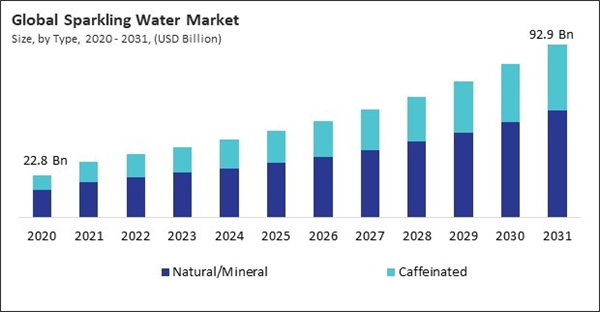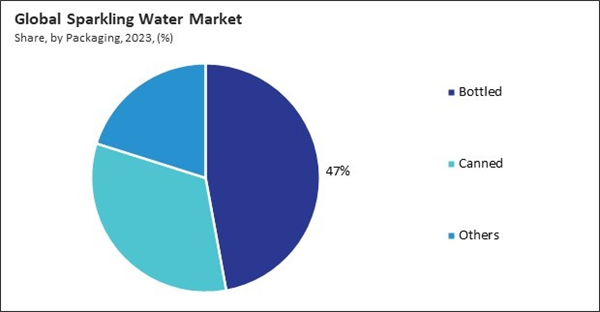The Global Sparkling Water Market size is expected to reach $92.9 billion by 2031, rising at a market growth of 12.1% CAGR during the forecast period. In the year 2023, the market attained a volume of 8,799.69 Kilo Tonnes experiencing a growth of 19.8% (2020-2023).
Rapid urbanization and increasing exposure to Western lifestyles and trends have contributed to the growing popularity of this water in the Asia Pacific region. Consequently, the Asia pacific region would acquire nearly 26% of the total market share by 2031. Also, the Chinese convenience stores are expected to register 447.27 kilo tonnes of volume by 2031. The water brands have introduced a wide range of flavors and flavor combinations tailored to Asian tastes and preferences. Exotic fruit flavors, floral infusions, and herbal blends are particularly popular among Asian consumers looking for unique and refreshing beverage options. The growing interest in health and wellness has increased demand for functional and wellness beverages in the Asia Pacific region.
Marketing and advertising campaigns help create brand awareness and visibility for the water brands, especially newer or niche brands entering the market. Social media platforms are powerful tools for marketing this water to consumers, especially younger demographics. Brands use platforms like Instagram, Facebook, and Twitter to engage with consumers, share user-generated content, and run targeted advertising campaigns to reach their target audience. Therefore, the market is expanding significantly due to the marketing and advertising campaigns. Additionally, Higher disposable income allows consumers to trade up to premium and high-quality products, including premium water brands. Consumers are willing to pay a premium for water brands that offer unique flavors, high-quality ingredients, and sophisticated packaging. Thus, because of the higher level of disposable income, the market is anticipated to increase significantly.
However, this water is often more expensive than tap water and other non-alcoholic beverages. Price-sensitive consumers may be reluctant to pay a premium for this water, especially when cheaper alternatives are available. High prices and cost considerations can limit the overall growth potential of the market. Thus, high cost can slow down the growth of the market.
Rapid urbanization and increasing exposure to Western lifestyles and trends have contributed to the growing popularity of this water in the Asia Pacific region. Consequently, the Asia pacific region would acquire nearly 26% of the total market share by 2031. Also, the Chinese convenience stores are expected to register 447.27 kilo tonnes of volume by 2031. The water brands have introduced a wide range of flavors and flavor combinations tailored to Asian tastes and preferences. Exotic fruit flavors, floral infusions, and herbal blends are particularly popular among Asian consumers looking for unique and refreshing beverage options. The growing interest in health and wellness has increased demand for functional and wellness beverages in the Asia Pacific region.
Marketing and advertising campaigns help create brand awareness and visibility for the water brands, especially newer or niche brands entering the market. Social media platforms are powerful tools for marketing this water to consumers, especially younger demographics. Brands use platforms like Instagram, Facebook, and Twitter to engage with consumers, share user-generated content, and run targeted advertising campaigns to reach their target audience. Therefore, the market is expanding significantly due to the marketing and advertising campaigns. Additionally, Higher disposable income allows consumers to trade up to premium and high-quality products, including premium water brands. Consumers are willing to pay a premium for water brands that offer unique flavors, high-quality ingredients, and sophisticated packaging. Thus, because of the higher level of disposable income, the market is anticipated to increase significantly.
However, this water is often more expensive than tap water and other non-alcoholic beverages. Price-sensitive consumers may be reluctant to pay a premium for this water, especially when cheaper alternatives are available. High prices and cost considerations can limit the overall growth potential of the market. Thus, high cost can slow down the growth of the market.
Type Outlook
By type, the market is bifurcated into natural/mineral and caffeinated. The caffeinated segment covered a 36% revenue share in the market in 2023. In terms of Volume, the caffeinated segment registered 2,856.02 kilo tonnes in 2023. Caffeinated uplift water provides a natural energy boost without the sugar and calories in traditional energy drinks and sodas. The caffeine content in uplift water helps consumers stay alert and focused throughout the day, making it a popular choice for those needing an energy boost.Packaging Outlook
Based on packaging, the market is classified into bottled, canned, others. The canned segment acquired a 32% revenue share in the market in 2023. Cans provide better protection against light and oxygen than other packaging materials, such as plastic bottles. This helps extend the shelf life of this water, ensuring that it maintains its freshness and quality for a longer period. Cans come in convenient single-serve sizes, making them an ideal choice for individual consumption.Distribution Channel Outlook
On the basis of distribution channel, the market is divided into supermarkets & hypermarkets, convenience store, online channel, and others. The online channel segment garnered a 20% revenue share in the market in 2023. In terms of volume, the online channel segment recorded 2,040.65 kilo tonnes in 2023. The online channel offers consumers the convenience of purchasing this water from the comfort of their homes. Consumers can order this water at any time, day or night, without the need to visit a physical store, saving time and effort.Regional Outlook
Region-wise, the market is analysed across North America, Europe, Asia Pacific, and LAMEA. In 2023, the North America region led the market by generating 37% revenue share. North American consumers are increasingly health-conscious and are seeking healthier beverage options. Rising obesity rates and concerns about excessive sugar consumption have prompted many North Americans to reduce their intake of sugary beverages. Fruit-infused waters and exotic and botanical flavors have gained popularity among North American consumers.List of Key Companies Profiled
- Nestle S.A.
- PepsiCo, Inc.
- Keurig Dr Pepper, Inc.
- The Coca Cola Company
- Montane Sparkling Spring Water
- WakeWater Beverage Co.
- National Beverage Corporation
- Big Watt Beverage Co.
- Danone S.A.
- Volay Brands, LLC
Market Report Segmentation
By Type (Volume, Kilo Tonnes, USD Billion, 2020-31)- Natural/Mineral
- Caffeinated
- Bottled
- Canned
- Others
- Supermarkets & Hypermarkets
- Convenience Stores
- Online
- Others
- North America
- US
- Canada
- Mexico
- Rest of North America
- Europe
- Germany
- UK
- France
- Russia
- Spain
- Italy
- Rest of Europe
- Asia Pacific
- China
- Japan
- India
- South Korea
- Singapore
- Malaysia
- Rest of Asia Pacific
- LAMEA
- Brazil
- Argentina
- UAE
- Saudi Arabia
- South Africa
- Nigeria
- Rest of LAMEA
Table of Contents
Chapter 1. Market Scope & Methodology
Chapter 2. Market at a Glance
Chapter 3. Market Overview
Chapter 4. Global Sparkling Water Market by Type
Chapter 5. Global Sparkling Water Market by Packaging
Chapter 6. Global Sparkling Water Market by Distribution Channel
Chapter 7. Global Sparkling Water Market by Region
Chapter 8. Company Profiles
Companies Mentioned
- Nestle S.A.
- PepsiCo, Inc.
- Keurig Dr Pepper, Inc.
- The Coca Cola Company
- Montane Sparkling Spring Water
- WakeWater Beverage Co.
- National Beverage Corporation
- Big Watt Beverage Co.
- Danone S.A.
- Volay Brands, LLC
Methodology

LOADING...










